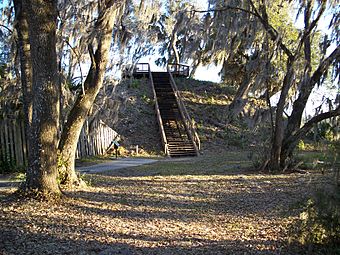Crystal River Archaeological State Park facts for kids
|
Crystal River Indian Mounds
|
|

Temple mound
|
|
| Location | Crystal River, Florida |
|---|---|
| Area | 61 acres (250,000 m2) |
| Visitation | 21,000 |
| NRHP reference No. | 70000178 |
Quick facts for kids Significant dates |
|
| Added to NRHP | September 29, 1970 |
| Designated NHL | June 21, 1990 |
The Crystal River State Archaeological Site is a special place in Florida. It's a 61-acre state park located right on the Crystal River. You can find it about two miles (3 km) northwest of the city of Crystal River.
This site is also known as the Crystal River Indian Mounds. It's so important that it was named a U.S. National Historic Landmark in 1990. This means it's a place with a lot of history that needs to be protected.
Contents
Discovering Crystal River's Ancient Past
This park holds a group of six ancient mounds. Native American people lived here for a very long time, about 1,600 years! They started living here around 250 BC and stayed until the Late Fort Walton period. This makes it one of the longest continually used sites in Florida.
Who Lived Here Long Ago?
Ancient Native Americans traveled from far away to visit this complex. They came to bury their loved ones and to trade goods. Experts believe that around 7,500 people might have visited the site each year. It was a very busy and important place.
What Are These Mounds?
The site has different kinds of mounds. There are burial mounds where people were laid to rest. There are also large platform mounds, which were likely used for ceremonies. You can also see a plaza area and a midden, which is like an ancient trash pile.
The oldest burials are in a cone-shaped mound. They date back to about 250 BC. Some people buried here had special copper tools and decorations. These copper items came from the Ohio River area. They were part of a trade network with the Hopewell culture. Over time, burial customs changed. Later burials didn't always include these copper items. This shows how traditions evolved over 2,000 years.
Life and Trade at the Site
For almost 1,900 years, starting around 500 BC, the people at Crystal River left behind many things. These items formed the middens you see today. The middens contain animal bones, fish bones, broken pottery, and old tools. By the time the site was left, the midden area was huge. It was about 1,300 feet long, 100 feet wide, and 7 feet deep. It was shaped like a crescent moon.
Two large platform mounds were probably used for important ceremonies. Today, you can walk a half-mile paved trail that goes past each mound. Signs explain what each mound was used for. There's even a 55-step observation deck on top of the largest mound, called Temple Mound. From there, you get an amazing view of the whole area. The park also has coastal marsh and is part of the Great Florida Birding Trail.
Mysterious Stone Carvings
At the park, you can also see a special limestone slab. It might be a "stele", which is a carved stone monument. This slab has a simple carving of a human face and body. It's unusual because similar carved slabs are mostly found in places like the Caribbean, South America, and Central America.
There were at least four of these large stones placed by the ancient inhabitants. The carving shows a person with long hair over their left shoulder. People have wondered if this carving was influenced by the large stone monuments of Mesoamerica. While there might have been some contact between cultures, direct connections are probably not true. Today, the slab is kept safe inside a metal cage at the site.
Exploring Roberts Island
Just a short distance downstream from the main park is Roberts Island. This island also has a group of mounds and middens. It was added to the park in 1996. Roberts Island became an important ceremonial center after the Crystal River site, around the 9th and 10th centuries.
Fun Things to Do Today
The Crystal River State Archaeological Site offers many fun activities. You can go fishing in both salt and fresh water. It's a great spot for a picnic or for bird watching. You can also take a boat tour of the Crystal River.
The visitor center has a museum with interesting exhibits. You can watch a video about the ancient tribes who lived here. The museum also displays many artifacts found at the site. These include arrowheads, pottery, jewelry, and tools made from stone and bone. A large model inside the museum shows what the site might have looked like centuries ago.
See Also
- Mound
- Mound builder (people)
- Earthwork (archaeology)



